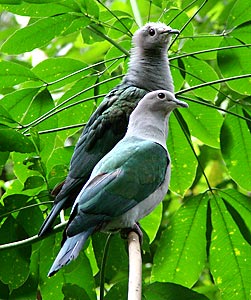 Karnataka is an important south Indian state having plenty of natural resources and the state is also famous for being home to numerous important wild plants, animals and birds. The state has a number of eco parks that are preserving this vast variety of wildlife. The Karnataka eco parks have earned considerable recognition and reputation all over the country for their wonderful wildlife collection. They are also quite famous for being popular tourist attractions. Among the several eco parks situated in the state, there are a few worth mentioning. These eco parks include the Nagarhole National Park, the Bandipur Tiger Reserve, the Bhadra Wildlife Sanctuary, the Ranganathittu Bird Sanctuary, etc.
Karnataka is an important south Indian state having plenty of natural resources and the state is also famous for being home to numerous important wild plants, animals and birds. The state has a number of eco parks that are preserving this vast variety of wildlife. The Karnataka eco parks have earned considerable recognition and reputation all over the country for their wonderful wildlife collection. They are also quite famous for being popular tourist attractions. Among the several eco parks situated in the state, there are a few worth mentioning. These eco parks include the Nagarhole National Park, the Bandipur Tiger Reserve, the Bhadra Wildlife Sanctuary, the Ranganathittu Bird Sanctuary, etc.
The Karnataka eco parks are generally concentrated on preserving the natural resources of the state and also in providing habitat to the endangered, critically endangered, threatened or endemic wildlife species. However, there are a few that are concentrated in preserving certain kind of wildlife like the Tiger of the Birds. While, the Bandipur Tiger Reserve is mainly working on conserving the endangered species of Tigers, the Ranganathittu Bird Sanctuary is concentrated on preserving the vast variety of bird species found in the state. The other eco parks are providing habitat to all kinds of flora and fauna species like the plants, reptiles, mammals, or the birds etc.
The need of preserving wildlife in the state of Karnataka in an organised way was felt as early as during the later half of the nineteenth century. However, the Nagarhole National Park was the first kind of wildlife sanctuary in the state. It was established by the famous King of Mysore, Hyder Ali, during the eighteenth century. During the 1890s, the naturalists and environmentalists of the state realised that the wildlife of the state should be preserved and hence, they started taking initiatives to establish eco parks. The Bandipur Tiger Reserve was one of the oldest wildlife sanctuaries to be founded in the state. After that, several other eco parks were established in the state for preserving the natural resources. Most of the Karnataka eco parks are situated of the foot of Western Ghats and this has made the parks splendidly picturesque, as well. Though, most of these parks were once the hunting ground of the kings, they are now declared as protected areas, with the help of government.
 The natural vegetation in the Karnataka eco parks is quite remarkable, as the parks are home to innumerous plant species that have great medicinal and commercial values. The parks are also home to a large number of important mammal species like the Tiger, Elephants, Gaur, Sambar, Spotted Deer, Leopard, Wild Dot (Dhole), Leopard-Cat, Rusty Spotted Cat, Small Indian Civet, Striped-Necked Mongoose, Ruddy Mongoose, Sloth Bear, Indian Giant Squirrel, etc. The important reptile species found in the Karnataka eco parks include several species of Snakes, Crocodiles, Tortoise, Turtles, etc. The Karnataka eco parks like Nagarhole National Park and Bandipur Tiger Reserve have seen a regular increase in the number of animals.
The natural vegetation in the Karnataka eco parks is quite remarkable, as the parks are home to innumerous plant species that have great medicinal and commercial values. The parks are also home to a large number of important mammal species like the Tiger, Elephants, Gaur, Sambar, Spotted Deer, Leopard, Wild Dot (Dhole), Leopard-Cat, Rusty Spotted Cat, Small Indian Civet, Striped-Necked Mongoose, Ruddy Mongoose, Sloth Bear, Indian Giant Squirrel, etc. The important reptile species found in the Karnataka eco parks include several species of Snakes, Crocodiles, Tortoise, Turtles, etc. The Karnataka eco parks like Nagarhole National Park and Bandipur Tiger Reserve have seen a regular increase in the number of animals.
Apart from the rich variety of natural vegetation and mammal species, the Karnataka eco parks also provide natural habitat to numerous bird species that are commonly found in the state. The important and notable bird species include Changeable Hawk Eagle, Besra, Crested Goshawk, Crested Serpent Eagle, Jerdon`s Baza, Osprey, Brown Fish Owl, Mottled Wood Owl, Grey Junglefowl, Indian Peafowl, Red Spurfowl, Painted Spurfowl and Painted Bush Quail. Great Hornbill, Malabar Pied Hornbill, White-bellied Woodpecker, Greater Flameback, Malabar Parakeet, Green Imperial Pigeon, Malabar Trogon, etc. Some of the flora and fauna species found in these eco parks are considered as endangered, critically endangered, threatened or endemic species. The Karnataka eco parks have also done well in prospering and increasing the population of these animal species.
Besides being the preserver of important wildlife species, the Karnataka eco parks are also playing an important role in the Tourism sector of the state. Almost all the eco parks in the state are considered as top favourite tourist destinations and they attract a large number of tourists from all over the world, every year. The Karnataka eco parks are actually making a double contribution like both preserving the natural resources and also promoting tourism in the state.











